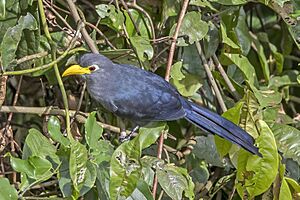Blue malkoha facts for kids
Quick facts for kids Blue malkoha |
|
|---|---|
 |
|
| C. a. flavirostris Ghana |
|
| Conservation status | |
| Scientific classification | |
| Genus: |
Ceuthmochares
|
| Species: |
aereus
|
| Subspecies | |
|
See text |
|
The blue malkoha, also called the chattering yellowbill, is a special kind of cuckoo bird. Its scientific name is Ceuthmochares aereus. This bird belongs to the Cuculidae family.
Until 2016, scientists thought it was the same as the green malkoha. But now we know they are different species! You can find the blue malkoha living all over the tropical rainforests in Africa.
Contents
About the Blue Malkoha
What Does It Look Like?
The blue malkoha has a grey belly, head, and throat. It also has a thick, bright yellow beak.
However, different types of blue malkohas can have slightly different colors. One type, C. aereus aereus, has a greenish-blue tail, wings, and back. Another type, C. aereus flavirostris, has a blue tail, wings, and back.
What Does It Eat?
This bird loves to eat insects! Its favorite snacks include caterpillars, beetles, grasshoppers, and crickets. Sometimes, it will also eat frogs, slugs, fruits, seeds, and even leaves.
The blue malkoha moves through thick plants by hopping from branch to branch. As it hops, it quickly grabs any prey it finds. It sometimes follows other birds or squirrels. This way, it can catch insects that these animals scare out of hiding.
Family Life
Unlike some other cuckoos, the blue malkoha is not a "brood parasite." This means it does not lay its eggs in other birds' nests. Instead, blue malkohas build their own nests and take care of their own babies.
They build a messy nest out of sticks. It usually hangs about 2 to 5 meters (6 to 16 feet) above the ground. The female bird lays two white or creamy eggs. Both the mother and father blue malkoha work together to raise their young.
Is It Rare?
The blue malkoha is not seen very often because it is a shy bird. It likes to stay hidden in the thick forest. Even though it's not often seen, it is not considered an endangered species. The IUCN (a group that checks on animals) lists it as "least concern." This means it's not currently at risk of disappearing.
Subspecies
The blue malkoha has two main types, called subspecies:


